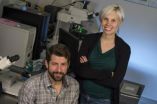(Press-News.org) CAMBRIDGE, Mass. (June 5, 2014) – Metastatic cancer cells, which can migrate from primary tumors to seed new malignancies, have thus far been resistant to the current arsenal of anticancer drugs. Now, however, researchers at Whitehead Institute have identified a critical weakness that actually exploits one of these cells' apparent strengths—their ability to move and invade tissues.
"This is the first vulnerability of invasive cancer cells that we really understand," says Whitehead Member Piyush Gupta, whose lab's latest work is described in the June issue of the journal Cancer Discovery. "For a while we didn't know if they had any vulnerabilities that could be exploited for therapy. Then, a few years ago we discovered they were exquisitely sensitive to some chemical molecules, and therefore had to have a weakness. But we still didn't know at the time what that weakness was. Now we know."
Cancer cells acquire invasive and stem cell-like traits by undergoing a process called an epithelial-to-mesenchymal transition (EMT), which transforms cube-like, immobile cells into elongated, mobile ones. Once mobile, cancer cells can form metastases by using the blood stream as an expressway to distant sites in the body, where they can establish new tumors. In addition to being invasive and metastatic, cancer cells that undergo an EMT are also resistant to radiation and most chemotherapies.
Although they are resistant to most therapies, Gupta and his colleagues had previously identified two compounds with very similar structures that were selectively toxic against the invasive cancer cells that had undergone an EMT, but not their non-invasive counterparts. These unique compounds were discovered in a large screen of over 300,000 chemical compounds.
Intrigued by these compounds that were selectively toxic to metastatic cancer cells, Yuxiong Feng, a postdoctoral researcher in Gupta's lab, further investigated their activity and discovered that the compounds kill by stressing the endoplasmic reticulum (ER) of EMT cells; non-EMT cells were unscathed because their ER was unaffected by these compounds. Feng also found that other chemicals that cause ER stress also similarly dispatched only the metastatic EMT cells. The obvious question was why these otherwise indestructible cells had such sensitive ERs.
A hint lies at the heart of EMT's physiology and function. Invasive cancer cells, like other mesenchymal cells, move by secreting large scaffolding proteins and other proteins that interact with the extracellular matrix, the structural support that holds neighboring cells together. Pumping out these proteins strains the cancer cells' ER to their limit. When Feng treated EMT cells with chemicals that further stressed their ER, the cells died. But when those cells' production of extracellular matrix proteins was artificially blocked, the cells were much less sensitive to the ER-stressing chemicals.
Feng's work points to one specific part of the process, called the PERK pathway, as being particularly important. This pathway helps cells survive the stress of secreting copious amounts of proteins, and in EMT cells, it is always active at a low level. In studying roughly 800 patient tumors (both primary and metastatic) across a range of cancer types, including breast, colon, gastric, and lung, Feng found that the expression of EMT genes was tightly correlated with PERK pathway activity.
"We've found that whenever you have EMT, the PERK pathway is more active," says Feng, who is the first author of the Cancer Discovery paper. "That means we might be able to use PERK pathway activity as a marker to help guide treatment, since tumors with higher PERK activity would likely be more sensitive to further ER stress."
As promising as these developments sound, Feng cautions that further work is needed before PERK screening could become mainstay of cancer diagnostics.
"Our research provides new insights into the biology and weaknesses of invasive cancer cells. Our findings also raise interesting and important questions for further study: how does the PERK pathway support the malignant function of EMT cells? What is the molecular circuitry activated upon EMT that causes cells to secrete copious amounts of extracellular matrix proteins? It's all very exciting."
INFORMATION:
This research is supported by the Richard and Susan Smith Family Foundation and the Breast Cancer Alliance.
Piyush Gupta's primary affiliation is with Whitehead Institute for Biomedical Research, where his laboratory is located and all his research is conducted. He is also an assistant professor of biology at Massachusetts Institute of Technology.
Full Citation:
"Epithelial-to-mesenchymal transition activates PERK-eIF2a and sensitizes cells to endoplasmic reticulum stress"
Cancer Discovery, June, 2014.
Yuxiong Feng (1), Ethan S. Sokol (1,2), Catherine A. Del Vecchio (1), Sandhya Sanduja (1), Jasper H.L. Claessen (1), Theresa Proia (1), Dexter X. Jin (1,2), Ferenc Reinhardt (1), Hidde L. Ploegh (1,2), Qiu Wang (3), Piyush B. Gupta (1,2, 4, 5, 6).
1. Whitehead Institute for Biomedical Research, 9 Cambridge Center, Cambridge, MA 02142, USA
2. Department of Biology, Massachusetts Institute of Technology, Cambridge, MA 02139, USA
3. Department of Chemistry, Duke University, Durham, NC 27708, USA
4. Koch Institute for Integrative Cancer Research, Cambridge, MA 02142, USA
5. Harvard Stem Cell Institute, Cambridge, MA 02142, USA
6. Broad Institute, Cambridge, MA 02142, USA
Seemingly invincible cancers stem cells reveal a weakness
2014-06-05
ELSE PRESS RELEASES FROM THIS DATE:
New evidence links air pollution to autism, schizophrenia
2014-06-05
A new study published in the journal Environmental Health Perspectives describes how exposure to air pollution early in life produces harmful changes in the brains of mice, including an enlargement of part of the brain that is seen in humans who have autism and schizophrenia.
As in autism and schizophrenia, the changes occurred predominately in males. The mice also performed poorly in tests of short-term memory, learning ability, and impulsivity.
The new findings are consistent with several recent studies that have shown a link between air pollution and autism ...
New findings out on brain networks in children at risk for mental disorders
2014-06-05
DETROIT – Attention deficits are central to psychiatric disorders such as schizophrenia or bipolar disorder, and are thought to precede the presentation of the illnesses. A new study led by Wayne State University School of Medicine researcher Vaibhav Diwadkar, Ph.D. suggests that the brain network interactions between regions that support attention are dysfunctional in children and adolescents at genetic risk for developing schizophrenia and bipolar disorder.
"The brain network mechanisms that mediate these deficits are poorly understood, and have rarely been tackled ...
Rice developing mobile DNA test for HIV
2014-06-05
Rice University bioengineers are developing a simple, highly accurate test to detect signs of HIV and its progress in patients in resource-poor settings.
The current gold standard to diagnose HIV in infants and to monitor viral load depends on lab equipment and technical expertise generally available only in clinics, said Rice bioengineer Rebecca Richards-Kortum. The new research features a nucleic acid-based test that can be performed at the site of care.
Richards-Kortum, director of the Rice 360˚: Institute for Global Health Technologies, and her colleagues reported ...
Iowa State, Ames Lab researchers find the mechanism that forms cell-to-cell catch bonds
2014-06-05
AMES, Iowa – Certain bonds connecting biological cells get stronger when they're tugged. Those bonds could help keep hearts together and pumping; breakdowns of those bonds could help cancer cells break away and spread.
Those bonds are known as catch bonds and they're formed by common adhesion proteins called cadherins. Sanjeevi Sivasankar, an Iowa State University assistant professor of physics and astronomy and an associate of the U.S. Department of Energy's Ames Laboratory, has described catch bonds as "nanoscale seatbelts. They become stronger when pulled."
But how ...
Short nanotubes target pancreatic cancer
2014-06-05
Short, customized carbon nanotubes have the potential to deliver drugs to pancreatic cancer cells and destroy them from within, according to researchers at Rice University and the University of Texas MD Anderson Cancer Center.
Pristine nanotubes produced through a new process developed at Rice can be modified to carry drugs to tumors through gaps in blood-vessel walls that larger particles cannot fit through.
The nanotubes may then target and infiltrate the cancerous cells' nuclei, where the drugs can be released through sonication – that is, by shaking them.
The ...
LSU biologist James Caprio, Japanese colleagues identify unique way catfish locate prey
2014-06-05
BATON ROUGE – Animals incorporate a number of unique methods for detecting prey, but for the Japanese sea catfish, Plotosus japonicus, it is especially tricky given the dark murky waters where it resides.
John Caprio, George C. Kent Professor of Biological Sciences at LSU, and colleagues from Kagoshima University in Japan have identified that these fish are equipped with sensors that can locate prey by detecting slight changes in the water's pH level.
A paper, "Marine teleost locates live prey through pH sensing," detailing the work of Caprio and his research partners, ...
Termites, fungi and climate change
2014-06-05
Climate change models could have a thing or two to learn from termites and fungi, according to a new study released this week.
For a long time scientists have believed that temperature is the dominant factor in determining the rate of wood decomposition worldwide. Decomposition matters because the speed at which woody material are broken down strongly influences the retention of carbon in forest ecosystems and can help to offset the loss of carbon to the atmosphere from other sources. That makes the decomposition rate a key factor in detecting potential changes to the ...
Brazil leads the world in reducing carbon emissions
2014-06-05
As the world turns its attention to Brazil with the opening of the World Cup this month, many people around the globe know the country's soccer fame, but few realize that it is the world's leader in reducing carbon emissions. A new study published in Science magazine provides the first in-depth analysis of how Brazil reached this global-leader status and managed to increase its agriculture production at the same time.
"Brazil is known as a leading favorite to win the World Cup, but they also lead the world in mitigating climate change," says the study's lead author, ...
New isotopic evidence supporting moon formation via Earth collision with planet-sized body
2014-06-05
A new series of measurements of oxygen isotopes provides increasing evidence that the Moon formed from the collision of the Earth with another large, planet-sized astronomical body, around 4.5 billion years ago. This work will be published in Science* on 6th June, and will be presented to the Goldschmidt geochemistry conference in California on 11th June.
Most planetary scientists believe that the Moon formed from an impact between the Earth and a planet-sized body, which has been given the name Theia. Efforts to confirm that the impact had taken place had centred ...
International collaboration explains sheep genome, secrets of unique digestive and metabolic systems
2014-06-05
HOUSTON – (June 6, 2014) -- An international team of scientists including the Human Genome Sequencing Center at Baylor College of Medicine has completed the first ever sequence of the sheep genome, shedding new information on the species' unique and specialized digestive and metabolic systems.
Sheep, a major source of meat, milk, and fiber in the form of wool, are important to the agriculture industry. This exploration of sheep genetic characteristics found features that comprise their specialized digestive systems including the rumen (the first chamber of their stomach ...



